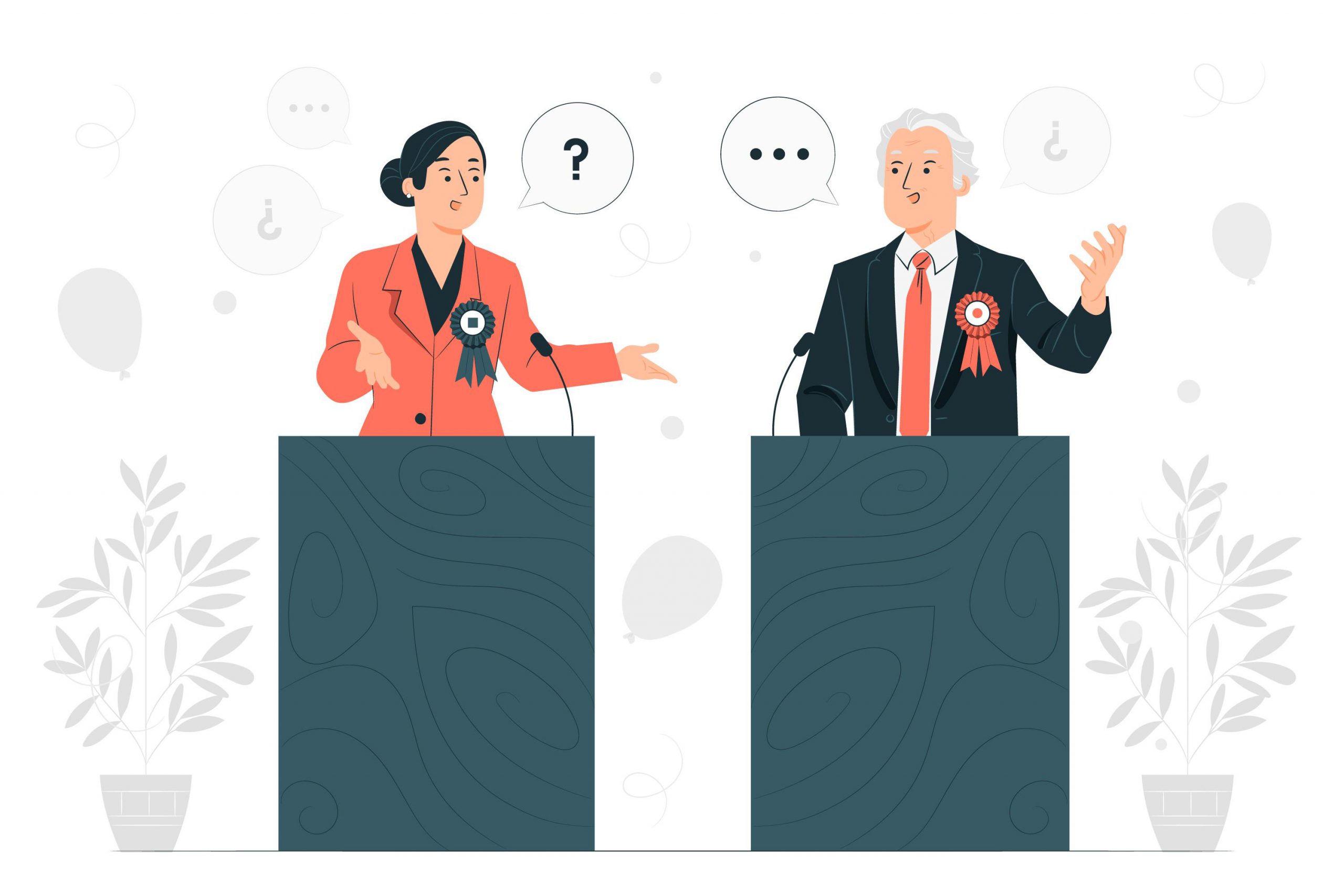6 Tips for Questioning


by Stormee Massey on 3/6/22
Imagine this: you are in a debate round and it is time for cross-fire. You know your opponents will be asking you questions, but you realize quickly that you don’t have any of your own questions to ask. Sometimes in debate, we get so caught up in our speeches, that we forget that cross-fire is coming up.
The most common result is that competitors ask open-ended informational questions to “suck up time”. Unfortunately, this is the worst strategy for cross-fire and could put you in a world of trouble when it comes to winning the debate.
So, let’s dive into a step-by-step guide on how to optimize your crossfire.

1. Consider Your Rebuttal
Crossfire is integral to rebuttal strategy! When you are thinking of questions to ask, consider what your answers are going to be in the next speech.
Let’s look at an example. If our topic is Resolved: The United States should ban homework. The pro side might say this could reduce stress. On opposition, consider how you would respond to this.
If we are going to say “banning homework could increase stress on tests because it will be the first time you get independent practice”, consider how you can set this argument up in crossfire. What questions can we ask that will make it easier to prove our argument in the speech.
For example, you could ask the question “Are there any other ways students will gain independent practice before the test?” Asking this question introduces the idea of your argument without giving it away.
As well, never ask a question you do not know the answer to; you never want your opponent to have an “ah-ha!” moment during crossfire. Be careful with the questions you ask and make sure you know exactly what the point of your question is.
2. Be Careful with Wording
The way that you word your questions can be make or break for your crossfire. If you ask questions that are too open-ended, this can result in your opponent talking forever about how awesome their case is. Sometimes, our gut instinct is to ask questions like “what is your impact in contention 1?”- consider how this would most likely be answered.
Asking open-ended information based questions can get you in trouble because it doesn’t move your strategy forward AND it gives the judge an opportunity to get to know your opponent’s arguments more. Asking questions that start with “why”, “how” or “can you explain” will result in your opponent talking as long as they want about whatever they think would benefit them the most in the round.
My best advice is to start with a yes or no question, then move to asking an open ended question. This will direct your opponent to where you want them to go, and then ask for more information, thus, avoiding unnecessary pit stops along the way to our goal.


3. Write Down Questions
This is one of the easiest, and probably most forgotten, ways to prepare for crossfire. Remember, the way we word our questions is very important. Consider how you gain ethos in crossfire: does asking a 30 second long meandering question make you seem like you know what you’re talking about or that you are confident in the answer you are looking for? The answer is no.
When a judge is evaluating crossfire, they are looking for clear and straight to the point questions with confident and succinct answers from the opponent. Specifically in Public Forum, if you try too hard to make arguments while formatting your question, it can be irritating to the judge.
This means, you need to write your questions down. Consider your rebuttals, and how the wording of the question will affect the answers. Try to come up with 2-3 questions during your opponent’s speech and write them down exactly how you plan to ask them.

4. Control the Crossfire
Nothing can be more annoying to a judge during a crossfire than when competitors devolve crossfire into a shouting match. Always remember, crossfire is for questions and answers. Arguing with your opponent will do little to establish ethos and will most likely result in you losing speaker points.
Instead, consider these strategies for getting crossfire back on track.
If you are asking questions and your opponent just won’t stop talking, consider using the phrase “Okay, that’s fine, thank you. You may have a question now.” Doing this can redirect the crossfire back to a question and answer format and prevent your opponent from sucking up all of the crossfire time with their answer.
On the other hand, if you are wanting to ask a question but your opponent keeps asking follow-ups, after providing an answer say “may I have a question, please?” This reminds your opponent that this is a back and forth process and they are getting out of hand.
Both of these strategies will work not only to help you gain control of crossfire, it will help get you brownie points with the judge. As mentioned before, judges hate when crossfire becomes a shouting match, so using these strategies will refocus the control of the questioning period.
5. Know When to Quit
This might be the hardest step for some. I have judged many debates where competitors will ask a question, get the answer they need, and then will circle back to the same question. Even if you reword the question, you are creating redundancy and revealing to your opponent where your main offense is.
You are more likely to generate ethos by asking a succinct thoughtful question, receiving an answer, and moving on to a different part of the debate. Circling back to a flag you have already planted can undermine your ethos and show your judge that you don’t know when you’ve won. Be confident when you get the answer you need because the judge will notice; don’t give your opponent an opportunity to wiggle out of the trap you put them in.


6. Refer to Crossfire
When you ask questions in crossfire that set up your rebuttal, this is called “planting the flag”. You want to establish your offense during crossfire so that you can refer back to it in your speech.
Some people view crossfire as a purely informational exchange, but this is far from the truth. Crossfire is where you establish credibility and set up your success in the debate. When you are giving speeches after crossfire, refer to questions and answers given during the questioning period to hold your opponents to their answers. This helps you reiterate how awesome your side is and prevents your opponent from squirreling out of an argument that they made and becoming a moving target.
These tips can all work wonders for your crossfire strategy. Just remember to RAWK in crossfire.
Rebuttal- consider what you are saying in rebuttal.
Approach- consider how you want to approach the questions ie yes or no/ open-ended.
Write- write your questions down and be prepared to ask them succinctly.
Know when to quit- don’t ask the same question when you get what you need.
If you can remember this phrase, the rest will fall into place.

